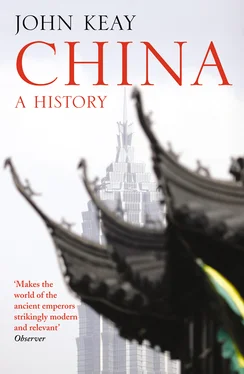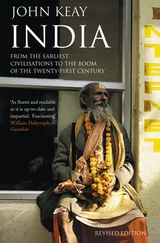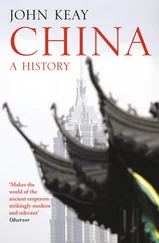The emperor concurred; and so began the great bamboo-book-burning of 213 BC. It was followed, according to later sources, by a purge in which some 460 scholars were either executed or buried alive. A far-fetched explanation offered for this second assault may simply disguise the need to halt any oral, as well as written, transmission of the texts. To a people who distinguished themselves from others on the basis of their historical awareness and essentially literary culture, the book-burning and the persecution of scholars were devastating blows. Popular sentiment would never forget them, scholarship never forgive them.
Yet the impact was certainly exaggerated. Books at the time were not numerous; nor were readers; and bamboo, though it burnt fiercely enough, also lasted well in concealment. Total suppression was probably impossible. In fact, give or take some of those ‘hundred schools of philosophy’, even the works specifically mentioned by Li Si survived. The historical records of Qin were exempted from destruction, and while those of the other ‘warring states’ were indeed depleted, the imperial archive is said to have retained copies of most ancient texts, including the Confucian classics. Several scholars have argued that a greater loss was sustained seven years later when Xianyang’s palaces, including the imperial archive itself, were ransacked by Qin’s victorious opponents. 17It could be another case of Qin’s reputation being burdened with the sins of its successors.
Seemingly the idea in 213 BC was not to abolish history and literature but to restrict access to them and so, as the Shiji puts it, ‘to make the common people ignorant and to see to it that no one in the empire used the past to criticise the present’. 18Yet the result was exactly the opposite: for in an effort to make good the supposed losses, Han scholars would scrutinise what survived even more intently. ‘Thus, if anything, its practical effect was to strengthen the tendency decried by Li Si of looking backward rather than toward the present.’ 19In short, Qin’s ‘cultural revolution’ entrenched the culture it was supposed to discredit while discrediting the revolution it was supposed to entrench.
CRUMBLING WALL, HIDDEN TOMB
That the dynasty responsible for first uniting much of what we now call ‘China’ should have crowned its achievement by lending its own name to its territorial creation seems logical enough. ‘Qin’ (pronounced ‘chin’) gave us ‘China’ – or so it is said. The word first found its way into the Indo-Aryan languages of Sanskrit and ancient Persian as ‘Sina’ or ‘Cina’, from them into Greek and Latin as ‘Sinai’ or ‘Thinai’, and from them into French and English as ‘Chine’ and ‘China’. Spin-offs like ‘sino’-phile and ‘sini’-fication were coined from the same pedigree by ‘sin’-ologists. In the most satisfying of equations, Qin is revealed as China’s etymological ancestor as well as its imperial ancestor; and a centralised empire with a distinctive culture becomes the defining characteristic of both.
But unlike zhongguo ’s flexible equation with ‘Central States’, ‘Middle Kingdom’ and then ‘Central Country’, the etymology of ‘Qin = China’ is far from straightforward. Sanskrit’s adoption of the ‘sin’/‘cin’ root seems to predate the rise of Qin; it could, in that case, derive from Jin (pronounced ‘zhin’), the hegemonic state headed by Chonger in the seventh century BC. Much later, the Graeco-Roman world in fact knew two Chinas: Sinai/Thinai and Seres (or Serica), both of which exported silk but were not thought to be the same place. Medieval Europe then added yet another, Cathay. This was the country that Marco Polo claimed to have visited. Polo seldom mentions anywhere called ‘Chin’ (or ‘China’) and then only as a possible alternative name for ‘Manzi’, which was the southern coastal region. 20In this restricted sense ‘Chin’/‘China’ was used by Muslim and then Portuguese traders, but it figured little in English until porcelain from this ‘Chin’ began gracing Elizabethan dinner tables. Shakespeare caught the mood in Measure for Measure with mention of stewed prunes being served in threepenny bowls and ‘not China dishes’. 21After long gestation, china (as porcelain) was lending currency to China (as place) – just as in Roman times seres (the Latin for ‘silk’) had led to the land itself being called ‘Seres’. Ultimately, then, it was contemporary crockery from the south of the country, not an ancient dynasty from the north, which secured the name of ‘China’ in everyday English parlance and led, by extension, to the term being applied to the whole empire.
Appropriately enough, Qin was acquainted with this later, southern, ‘Chin’. In the wake of his victory over Chu (including Wu and Yue) the First Emperor extended his conquests deep into the extreme south of the country. They seem to have embraced Guangdong province and parts of Guangxi and Fujian (which together formed Marco Polo’s ‘Chin’), plus on paper at any rate what is now northern Vietnam. But uncertainty surrounds not only the extent of these acquisitions but also their timing. If, as the Shiji has it, Qin’s successful southern campaign was in 214 BC, this was only four years before the First Emperor’s untimely death and the rapid disintegration of his empire. Three new commanderies are said to have been established in the south, but since all would have to be reconquered by the Han dynasty, it must be doubtful whether Qin’s control was fully effective. Whatever its extent, the First Emperor’s southern dominion was fleeting.
As in Sichuan, though, it was notable for the cutting of an important canal. This linked a southern tributary of the Yangzi to a northern tributary of the West River, which itself debouches into the estuary of the Pearl River near Hong Kong. Designed in 219 BC to facilitate a southern advance and to provide an inland waterway through Hunan to Guangzhou (Canton), the canal would be much realigned but, like Li Bing’s waterworks, still exists. In the same year, the emperor himself reached the southernmost point of his imperial travels when he turned back somewhere just short of the proposed canal in the vicinity of Changsha. At the time the hill country to the south had not yet been secured, which should have been a good enough reason for heading north again. But the Shiji offers a different explanation, indeed one that seems designed to reveal an imperial trait which was of growing concern to ministers such as Li Si and to the whole Qin court.
Apparently the emperor was much drawn to hilltops. His inscribed stelae were usually positioned on them and he liked to climb them in person. But on an eminence near Changsha his progress was halted by what sounds like a tornado. Taking this as a personal affront, he excused the wind but blamed the hill, ordering it to be stripped of trees and painted red. Three thousand convicts were put to work immediately. Since ‘red was the colour worn by condemned criminals’ 22and clear-felling the nearest thing to limb-by-limb amputation, it is evident that the hill was being punished for lèse-majesté . Delusions of more than mere grandeur were afflicting the emperor: a sense of transcendence had overcome him; ‘all under Heaven’ was his, and that included natural features. When some 2,200 years later Comrade Mao’s Long Marchers sang songs about ‘painting the countryside red’, they may not have been aware of this ominous precedent.
More significant, because it resulted in the construction of the so-called Great Wall, was the empire’s extension northwards. Sima Qian’s Shiji continues to be vague about the geography and chronology, but it seems that the First Emperor’s conquests extended right along the northern perimeter of the erstwhile ‘warring states’ and that these conquests were undertaken continuously throughout his eleven years as emperor (221–210 BC). As in Sichuan, colonists were speedily dispatched to the newly conquered territories; and frequent mention of these deployments provides a few clues as to the advance. So does the alignment, insofar as it can be established, of the Qin wall, part of which was much farther north than most of its successors. On this basis, the First Emperor’s forces look to have mounted a three-pronged advance, pushing north of west to Lanzhou in Gansu province, north of east to the edge of the Korean peninsula, and due north across the Ordos, an undulating desert wilderness within the Yellow River’s great northern loop, towards Mongolia.
Читать дальше












